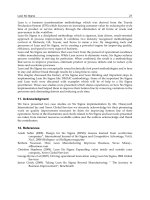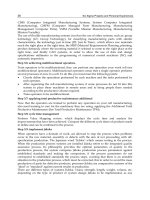peopleware productive projects and teams
Bạn đang xem bản rút gọn của tài liệu. Xem và tải ngay bản đầy đủ của tài liệu tại đây (2.87 MB, 261 trang )
Peopleware
Productive Projects
and Teams
2nd ed.
Tom DeMarco
&
Timothy Lister
Dorset House Publishing Co.
353 West 12th Street
New York, NY 10014
Library of Congress Cataloging-in-Publication Data
DeMarco. Tom.
Peopleware : productive projects and teams / Tom DeMarco & Timothy
Lister. 2nd ed.
p. cm.
Includes bibliographical references and index.
ISBN
0-932633-43-9
softcover
1. Management. 2. Organizational behavior. 3. Organizational
effectiveness. 4. Industrial project management. I. Lister,
Timothy R. II. Title.
HD31.D42185 1999
658.3'14—dc21 99-11525
CIP
CREDITS
For the Cover Art:
"One Sunday Afternoon I Took a Walk Through the Rose Garden, 1981" by
Herbert Fink.
For the Cover Design:
Jeff Faville, Faville Graphics
For the Dedication:
THE WIZARD OF OZ © 1939 Loew's Incorporated
Ren. 1966Metro-Goldwyn-MayerInc.
For the Excerpts in Chapter 3, from "Vienna" by Billy Joel:
Copyright © 1977 Joelsongs.
All Rights Controlled and Administered by Gelfand, Rennert & Feldman, Inc.
International Copyright Secured. Made in U.S.A. All Rights Reserved.
For the Excerpts and Graphics in Chapter 13, thanks to Oxford University Press:
From The Oregon Experiment by Christopher Alexander. Copyright © 1975
by Christopher Alexander. Used by permission of Oxford University Press,
Inc. From A Pattern Language by Christopher Alexander. Copyright © 1977
by Christopher Alexander. Used by permission of Oxford University Press,
Inc. From The Timeless Way of Building by Christopher Alexander. Copyright
© 1979 by Christopher Alexander. Used by permission of Oxford University
Press, Inc.
For Figure 29.1, The SEI Capability Maturity Model, on page 190:
From J.W.E. Greene, "Software Process Improvement: Management
Commitment, Measures, and Motivation," Managing System Development
(February 1998), p. 4. Used by permission.
Copyright © 1999, 1987 by Tom DeMarco and Timothy Lister. Published by
Dorset House Publishing Co., Inc., 353 West 12th Street, New York, NY 10014.
All rights reserved. No part of this publication may be reproduced, stored in a retrieval
system, or transmitted, in any form or by any means, electronic, mechanical, photo-
copying, recording, or otherwise, without prior written permission of the publisher.
Distributed in the English language in Singapore, the Philippines, and Southeast
Asia by Alkem Company (S) Pte. Ltd., Singapore; in the English language in India,
Bangladesh, Sri Lanka, Nepal, and Mauritius by Prism Books Pvt., Ltd., Bangalore,
India; and in the English language in Japan by Toppan Co., Ltd., Tokyo, Japan.
Printed in the United States of America
Library of Congress Catalog Number 99-11525
ISBN: 0-932633-43-9 24 23 22 21 20 19 18 17 16 15 14 13
The Great Oz has spoken.
Pay no attention to that man behind the curtain.
The Great Oz has spoken.
—The Wizard of O
To all our friends and colleagues who have shown us
how to pay no attention to the man
behind the curtain
Contents
Acknowledgments ix
Preface to the Second Edition xi
Preface to the First Edition xiiii
PARTI: MANAGING THE HUMAN RESOURCE 1
1. Somewhere Today, a Project Is Failing 3
2. Make a Cheeseburger, Sell a Cheeseburger 7
3. Vienna Waits for You 13
4. Quality—If Time Permits 19
5. Parkinson's Law Revisited 24
6. Laetrile 30
PART II: THE OFFICE ENVIRONMENT 35
7. The Furniture Police 37
8. "You Never Get Anything Done Around Here
Between 9 and 5" 42
9. Saving Money on Space 51
Intermezzo: Productivity Measurement and
Unidentified Flying Objects 58
10. Brain Time Versus Body Time 62
11. The Telephone 69
VII
viii CONTENTS
12. Bring Back the Door 75
13. Taking Umbrella Steps 81
PART III: THE RIGHT PEOPLE 93
14. The Hornblower Factor 95
15. Hiring a Juggler 100
16. Happy to Be Here 105
17. The Self-Healing System 113
PART IV: GROWING PRODUCTIVE TEAMS 121
18. The Whole Is Greater Than the Sum of the Parts 123
19. The Black Team 129
20. Teamicide 132
21. A Spaghetti Dinner 140
22. Open Kimono 143
23. Chemistry for Team Formation 150
PART V: IT'S SUPPOSED TO BE FUN
TO WORK HERE 157
24. Chaos and Order 159
25. Free Electrons 167
26. HolgarDansk 171
PART VI: SON OF PEOPLEWARE 175
27. Teamicide Revisited 177
28. Competition 181
29. Process Improvement Programs 186
30. Making Change Possible 194
31. Human Capital 202
32. Organizational Learning 209
33. The Ultimate Management Sin Is 215
34. The Making of Community 222
Notes 227
Bibliography 233
Index 239
About the Authors 248
Acknowledgments
For the First Edition
It's always a surprise that a simple, little film with three actors
may list credits at the end for fifty to a hundred people. Some of
their titles are so obscure as to give no hint of what the named
people may actually have done. Yet the film could not have been
made without them.
So, too, the making of a book, even a slender one like this,
depends on the efforts of a great many people. We didn't make
use of gaffers or best boys or hair consultants. But we did profit
from the contributions of friends and colleagues who served vari-
ously as quipsters, phrase makers, manuscript sloggers, idea
debunkers, anecdoters, tone correctors, participle undanglers,
silliness detectors, and one-war-story-too-many deleters. Chief
among these has been our editor, Janice Wormington. She has
managed our efforts and given unstintingly of her great energy,
competence, and (usually) good humor.
Mark Wallace of Information Engineering and Linda
Prowse of Hewlett-Packard were generous and patient enough to
make repeated passes through early versions of the manuscript
and to suggest numerous possibilities for improvement. And each
of the following has contributed (knowingly or un-) at least one
idea: Colin Corder, Art Davidson, Wendy Eakin, Justin Kodner,
Steve McMenamin, Lou Mazzucchelli, Nancy Meabon, Ken Orr,
IX
x ACKNOWLEDGMENTS
Meilir Page-Jones, John Palmer, James and Suzanne Robertson,
John Taylor, and Dave Tommela. We are particularly indebted to
the professional developersr who have participated in our produc-
tivity surveys and war game exercises in the years 1977 to 1987.
Our thanks to all of them.
The philosophy expressed in these pages is in part the prod-
uct of kind and caring managers we have worked with in the past.
Among these we list Johnny Johanessen and Al Stockert (Bell
Telephone Laboratories), Sven-Olof Reftmark and Harry
Nordstrom (Swedish Philips), Gerard Bauvin (La SLIGOS), Ron
Hester (now at IMI Systems), Bill Plauger (now at Whitesmiths,
Ltd.), Nancy Rimkus (American Express), and Jerry Wiener,
wherever he may be.
For the Second Edition
For the 1999 edition, we are indebted to David McGlintock,
Michael Lumelsky, Matt McDonald, and Wendy Eakin (all of
Dorset House) for editing and sage advice about the new chap-
ters. For specific insights, and more general guidance, we are
grateful to Peter Hruschka, Steve McMenamin, Mark Weisz,
Bruce Taylor (a.k.a. Walter "Bunny" Formaggio), James Bach,
Rich Cohen, Tomoo Matsubara, Tsueneo Yamaura, and the Guild
voice instructor, Verona Chard.
Preface to the
Second Edition
As we write these words, the first edition of Peopleware has
just passed its tenth anniversary.
I When the book came out all those years ago, we certainly
thought we were done, but time and our correspondence and e-mail
have convinced us otherwise. We seem to have been nominated
to serve as custodians of an international clearinghouse for peo-
pleware-related developments. Readers have written to us from
all corners of the earth to report on new kinds of teamicide,
attacks by the Furniture Police and counterattacks thereon, and all
sorts of managerial silliness about visual supervision, noise in the
workplace, and motivational schemes that demotivate. They have
also written to tell us of organizations where work is so much fan
that employees feel sheepish about cashing their paychecks, or
where project managers have succeeded in forming stable and
healthy little communities around the work.
We found, too, that we had much more to say on the subject.
Our own experience with peopleware matters continued to grow
through project consulting and work with client managers.
Slowly but surely, the giant, Holgar Dansk, began to stir again for
us. (You're going to have to read Chapter 26 to understand that.)
When the giant beckons, you ignore him at your peril. And so
evolved this second edition.
Rereading Peopleware with somewhat older eyes has shown
us something that wasn't so evident at the time of first publica-
xii PREFACE
tion: The book is not so much a collection of essays (that's what
we called it in the original Preface) as it is a book of stories.
Each of the principles we set out to describe has its story. There
is also a story in the way these principles affected us in our own
careers.
Not told in the original work is the story of Peopleware
itself: how the book was written and what impact it had on its
authors. Peopleware, a book about partnership, was written by a
partnership. It is a book about teams and was itself put together
by a team, including authors, editors, artists, and draft readers.
Most of all, the making of the book illustrated one of its most
essential themes: that owning part of a good work somehow feels
better than owning all of it. This may seem like an odd notion,
but if you've ever been part of a well-formed team or a harmo-
nious work group, you'll know what we mean.
For the second edition, we have added a Part VI and made
only a few, minor changes to the first five parts. We found only
one instance of a new work practice that forced us to revisit the
conclusions of the first edition. That change was the introduction
of voice-mail. In the original Chapter 11, we tried to persuade
you that interrupting yourself to answer the telephone in the mid^t
of a thought-intensive task was an exercise in frustration and lost
productivity. You seem to have agreed—since writing the book,
we've been unable to reach anyone by phone, anywhere. The
change in phone use is both good and bad, and in our revised end-
ing to Chapter 11, we comment on what voice-mail has taught us
about interruption and a sensibly managed work environment.
The new Part VI, Son of Peopleware, has chapters on teams
and teamicide, process improvement programs, internal competi-
tion, change and change management, human capital, wasting time,
organizational learning, and what we call Aristotelian politics.
August 1998 —Tom DeMarco
Camden, Maine
—Tim Lister
New York, New York
Preface to the
First Edition
If you have ever undertaken a major development effort,
you almost certainly know the wisdom of the adage, "Build one
to throw away." It's only after you're finished that you know
how the thing really should have been done. You seldom get to
go back and do it again right, of course, but it would be nice.
This same idea can be applied to whole careers. Between
the two of us, we've spent nearly thirty years managing projects
or consulting on project management. Most of what we've
learned, we've learned from doing it wrong the first time. We've
never had the luxury of managing any of those projects over
again to do it entirely right. Instead, we've written this book.
It's put together as a series of short essays, each one about a
particular garden path that managers are led down, usually to
then: regret. What typically lures them into error is some aspect
of management folklore, a folklore that is pervasive and loudly
articulated, but often wrong. We've been lured down all those
garden paths ourselves. If the book succeeds, it will help you to
avoid at least some of them.
The folklore is full of easy remedies: Take the worker's
estimate and double it. Keep the pressure on. Don't let people
work at home, they'll only goof off. The remedies suggested in
these pages are anything but easy. They draw your attention to
the complex requirements of human individuality, to the highly
political arena of the office environment, to the puzzle of keeping
XIII
xiv PREFACE
good people, to the intriguing, sometimes exasperating subject of
teams, and finally to the elusive concept of fun.
Since this is a very personal work for us, we have elected
from time to time to retain our individual voices. Whenever a
singular voice is used in the text, the initials indicated will let you
know which of the authors is speaking.
The body of the text contains no citations or footnotes.
Sources of quoted material and other explanatory matter are pre-
sented in the Notes section, keyed to page number and to the
Bibliography, where complete references are provided.
September 1987 —Tom DeMarco
Camden, Maine
—Timothy Lister
New York, New York
Peopleware
Productive Projects
and Teams
2nd ed.
PART I
MANAGING THE HUMAN
RESOURCE
Most of us as managers are prone to one particular failing: a
tendency to manage people as though they were modular com-
ponents. It's obvious enough where this tendency comes from.
Consider the preparation we had for the task of management: We
were judged to be good management material because we performed
well as doers, as technicians and developers. That often involved
organizing our resources into modular pieces, such as software rou-
tines, circuits, or other units of work. The modules we constructed
were made to exhibit a black-box characteristic, so that their internal
idiosyncrasies could be safely ignored. They were designed to be
used with a standard interface.
After years of reliance on these modular methods, small won-
der that as newly promoted managers, we try to manage our human
resources the same way. Unfortunately, it doesn't work very well.
In Part I, we begin to investigate a very different way of
thinking about and managing people. That way involves specific
accommodation to the very nonmodular character of the human
resource.
Chapter 1
SOMEWHERE TODAY,
A PROJECT IS FAILING
Since the days when computers first came into common use,
there must have been tens of thousands of accounts receivable pro-
grams written. There are probably a dozen or more accounts re-
ceivable projects underway as you read these words. And some-
where today, one of them is failing.
Imagine that! A project requiring no real technical innovation
is going down the tubes. Accounts receivable is a wheel that's been
reinvented so often that many veteran developers could stumble
through such projects with their eyes closed. Yet these efforts
sometimes still manage to fail.
Suppose that at the end of one of these debacles, you were
called upon to perform an autopsy. (It would never happen, of
course; there is an inviolable industry standard that prohibits exam-
ining our failures.) Suppose, before all the participants had scurried
off for cover, you got a chance to figure out what had gone wrong.
One thing you would not find is that the technology had sunk the
project. Safe to say, the state of the art has advanced sufficiently so
that accounts receivable systems are technically possible. Some-
thing else must be the explanation.
Each year since 1977, we have conducted a survey of devel-
opment projects and their results. We've measured project size,
cost, defects, acceleration factors, and success or failure in meeting
schedules. We've now accumulated more than five hundred project
histories, all of them from real-world development efforts.
We observe that about fifteen percent of all projects studied
came to naught: They were canceled or aborted or "postponed" or
4 PEOPLEWARE
they delivered products that were never used. For bigger projects,
the odds are even worse. Fully twenty-five percent of projects that
lasted twenty-five work-years or more failed to complete. In the
early surveys, we discarded these failed data points and analyzed the
others. Since 1979, though, we've been contacting whoever is left
of the project staff to find out what went wrong. For the over-
whelming majority of the bankrupt projects we studied, there was
not a single technological issue to explain the failure,
The Name of the Game
The cause of failure most frequently cited by our survey participants
was "politics." But now observe that people tend to use this word
rather sloppily. Included under "politics" are such unrelated or
loosely related things as communication problems, staffing prob-
lems, disenchantment with the boss or with the client, lack of moti-
vation, and high turnover. People often use the word politics to
describe any aspect of the work that is people-related, but the
English language provides a much more precise term for these
effects: They constitute the project's sociology. The truly political
problems are a tiny and pathological subset.
If you think of a problem as political in nature, you tend to be
fatalistic about it. You know you can stand up to technical chal-
lenges, but honestly, who among us can feel confident in the realm
of politics? By noting the true nature of a problem as sociological
rather than political, you make it more tractable. Project and team
sociology may be a bit outside your field of expertise, but not
beyond your capabilities.
Whatever you name these people-related problems, they're
more likely to cause you trouble on your next assignment than all the
design, implementation, and methodology issues you'll have to deal
with. In fact, that idea is the underlying thesis of this whole book:
The major problems of our work are not so much
technological as sociological in nature.
Most managers are willing to concede the idea that they've got
more people worries than technical worries. But they seldom man-
age that way. They manage as though technology were their princi-
pal concern. They spend their time puzzling over the most con-
voluted and most interesting puzzles that their people will have to
SOMEWHERE TODAY, A PROJECT IS FAILING 5
solve, almost as though they themselves were going to do the work
rather than manage it. They are forever on the lookout for a techni-
cal whiz-bang that promises to automate away part of the work (see
Chapter 6, "Laetrile," for more on this effect). The most strongly
people-oriented aspects of their responsibility are often given the
lowest priority.
Part of this phenomenon is due to the upbringing of the aver-
age manager. He or she was schooled in how the job is done, not
how the job is managed. It's a rare firm in which new managers
have done anything that specifically indicates an ability or an apti-
tude for management. They've got little management experience and
no meaningful practice. So how do new managers succeed in con-
vincing themselves that they can safely spend most of their time
thinking technology and little or no time thinking about the people
side of the problem?
The High-Tech Illusion
Perhaps the answer is what we've come to think of as the High-
Tech Illusion: the widely held conviction among people who deal
with any aspect of new technology (as who of us does not?) that
they are in an intrinsically high-tech business. They are indulging in
the illusion whenever they find themselves explaining at a cocktail
party, say, that they are "in computers," or "in telecommunications,"
or "in electronic funds transfer." The implication is that they are part
of the high-tech world. Just between us, they usually aren't. The
researchers who made fundamental breakthroughs in those areas are
in a high-tech business. The rest of us are appliers of their work.
We use computers and other new technology components to develop
our products or to organize our affairs. Because we go about this
work in teams and projects and other tightly knit working groups,
we are mostly in the human communication business. Our success-
es stem from good human interactions by all participants in the
effort, and our failures stem from poor human interactions.
The main reason we tend to focus on the technical rather than
the human side of the work is not because it's more crucial, but
because it's easier to do. Getting the new disk drive installed is pos-
itively trivial compared to figuring out why Horace is in a blue funk
or why Susan is dissatisfied with the company after only a few
months. Human interactions are complicated and never very crisp
and clean in their effects, but they matter more than any other aspect
of the work.
6 PEQPLEWARE
If you find yourself concentrating on the technology rather
than the sociology, you're like the vaudeville character who loses
his keys on a dark street and looks for them on the adjacent street
because, as he explains, "The light is better there."
Chapter 2
MAKE A CHEESEBURGER,
SELL A CHEESEBURGER
Development is inherently different from production. But
managers of development and allied efforts often allow their think-
ing to be shaped by a management philosophy derived entirely from
a production environment.
Imagine for the moment that you're the manager of the local
fast food franchise. It makes perfect sense for you to take any or all
of the following efficient production measures:
• Squeeze out error. Make the machine (the human ma-
chine) run as smoothly as possible.
Take a hard line about people goofing off on the job.
• Treat workers as interchangeable pieces of the machine.
• Optimize the steady state. (Don't even think about how the
operation got up to speed, or what it would take to close it
down.)
• Standardize procedure. Do everything by the book.
• Eliminate experimentation—that's what the folks at head-
quarters are paid for.
These would be reasonable approaches if you were in the fast food
business (or any production environment), but you're not. The
"make a cheeseburger, sell a cheeseburger" mentality can be fatal in
your development area. It can only serve to damp your people's
spirits and focus their attention away from the real problems at hand.
This style of management will be directly at odds with the work.
8 PEOPLEWARE
To manage thinking workers effectively, you need to take
measures nearly opposite those listed above. Our proposed opposite
approaches are described in the following sections.
A Quota for Errors
For most thinking workers, making an occasional mistake is a natu-
ral and healthy part of their work. But there can be an almost Bibli-
cal association between error on the job and sin. This is an attitude
we need to take specific pains to change.
Speaking to a group of software managers, we introduced a
strategy for what we think of as iterative design. The idea is that
some designs are intrinsically defect-prone; they ought to be reject-
ed, not repaired. Such dead ends should be expected in the design
activity. The lost effort of the dead end is a small price to pay for a
clean, fresh start. To our surprise, many managers felt this would
pose an impossible political problem for their own bosses: "How
can we throw away a product that our company has paid to pro-
duce?" They seemed to believe that they'd be better off salvaging
the defective version even though it might cost more in the long run.
Fostering an atmosphere that doesn't allow for error simply
makes people defensive. They don't try things that may turn out
badly. You encourage this defensiveness when you try to system-
atize the process, when you impose rigid methodologies so that staff
members are not allowed to make any of the key strategic decisions
lest they make them incorrectly. The average level of technology
may be modestly improved by any steps you take to inhibit error.
The team sociology, however, can suffer grievously.
The opposite approach would be to encourage people to make
some errors. You do this by asking your folks on occasion what
dead-end roads they've been down, and by making sure they
understand that "none" is not the best answer. When people blow
it, they should be congratulated—that's part of what they're being
paid for.
Management: The Bozo Definition
Management is a complex enough thing to defy simple definition,
but that nuance was lost on one senior manager we encountered at a
professional society meeting in London. He summed up his entire









